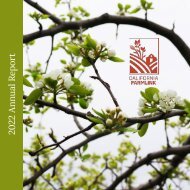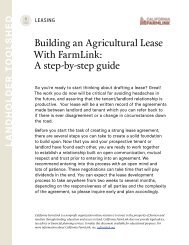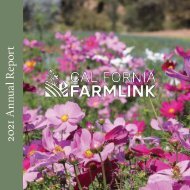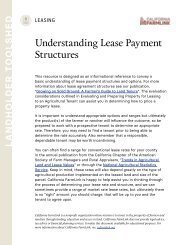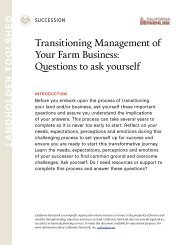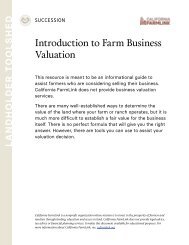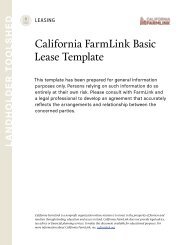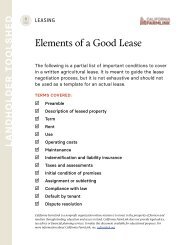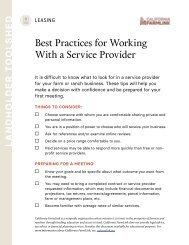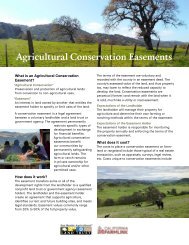Guide to Regenerative Grazing Leases: Opportunities for Resilience
California FarmLink and TomKat Ranch Educational Foundation teamed up to create this resource focused on land leases that support regenerative grazing practices. This guidebook aims to empower private, nonprofit, and public landholders, as well as easement-holders and grazing tenants.
California FarmLink and TomKat Ranch Educational Foundation teamed up to create this resource focused on land leases that support regenerative grazing practices. This guidebook aims to empower private, nonprofit, and public landholders, as well as easement-holders and grazing tenants.
Create successful ePaper yourself
Turn your PDF publications into a flip-book with our unique Google optimized e-Paper software.
CHAPTER 4. In<strong>to</strong> the Next Generation (Continued)<br />
Regenerating Land and Communities<br />
How else are <strong>to</strong>day’s landholders using their land <strong>to</strong> regenerate human communities?<br />
Christine Pielenz and Bill Laven founded Potrero Nuevo Farm on 300 acres in Half<br />
Moon Bay with a goal of providing free and healthy produce <strong>to</strong> people in need<br />
while building healthy soil. With their nonprofit partner, Abundant Grace Coastside<br />
Worker, Potrero Nuevo Farm grows, harvests, and donates over 20,000 pounds of<br />
fresh, organic produce <strong>to</strong> low-income residents in the area. TomKat Ranch manages<br />
cattle on their Pescadero, CA property <strong>to</strong> uphold shared ecological values and model<br />
regenerative grazing practices. Peninsula Open Space Trust holds an agricultural<br />
conservation easement on the land, protecting it from development and ensuring a<br />
future of healthy soil and productive agriculture.<br />
Community Land Trusts and Agrarian Commons<br />
Some ranch owners facing the end of the line envision a future of af<strong>for</strong>dable land<br />
access by regenerative, working farmers and ranchers, and cannot find a viable path<br />
<strong>to</strong> do so within the private real estate market. Whereas conservation land trusts<br />
generally hold easements in partnership with private landowners, community land<br />
trusts were <strong>for</strong>med as nonprofit landholders, in which long-term or lifetime tenure<br />
is conveyed <strong>to</strong> qualifying members of the community. The Agrarian Commons,<br />
organized under umbrella organization Agrarian Trust, holds clusters of agricultural<br />
properties in trust <strong>for</strong> their communities—supporting regenerative land stewardship,<br />
local food production, and equitable access <strong>for</strong> working producers.<br />
IN SUMMARY<br />
There is an urgent need <strong>for</strong> landholders <strong>to</strong> take the bull by the horns—<strong>to</strong> proactively<br />
begin trans<strong>for</strong>ming land tenure, access and stewardship practices. Landholders are<br />
in a unique and empowered position <strong>to</strong> align the management of their land with their<br />
values and directly impact the health of their communities, ecosystems, and even the<br />
planet as a whole. By working creatively with the next generation, landholders can<br />
see their land be honored and cared <strong>for</strong>, support the regeneration and trans<strong>for</strong>mation<br />
of the ranching industry, and build a diverse and equitable system of ecological,<br />
economic, and community resilience.<br />
© Copyright 2022 Cali<strong>for</strong>nia FarmLink and TomKat Ranch Educational Foundation<br />
53



